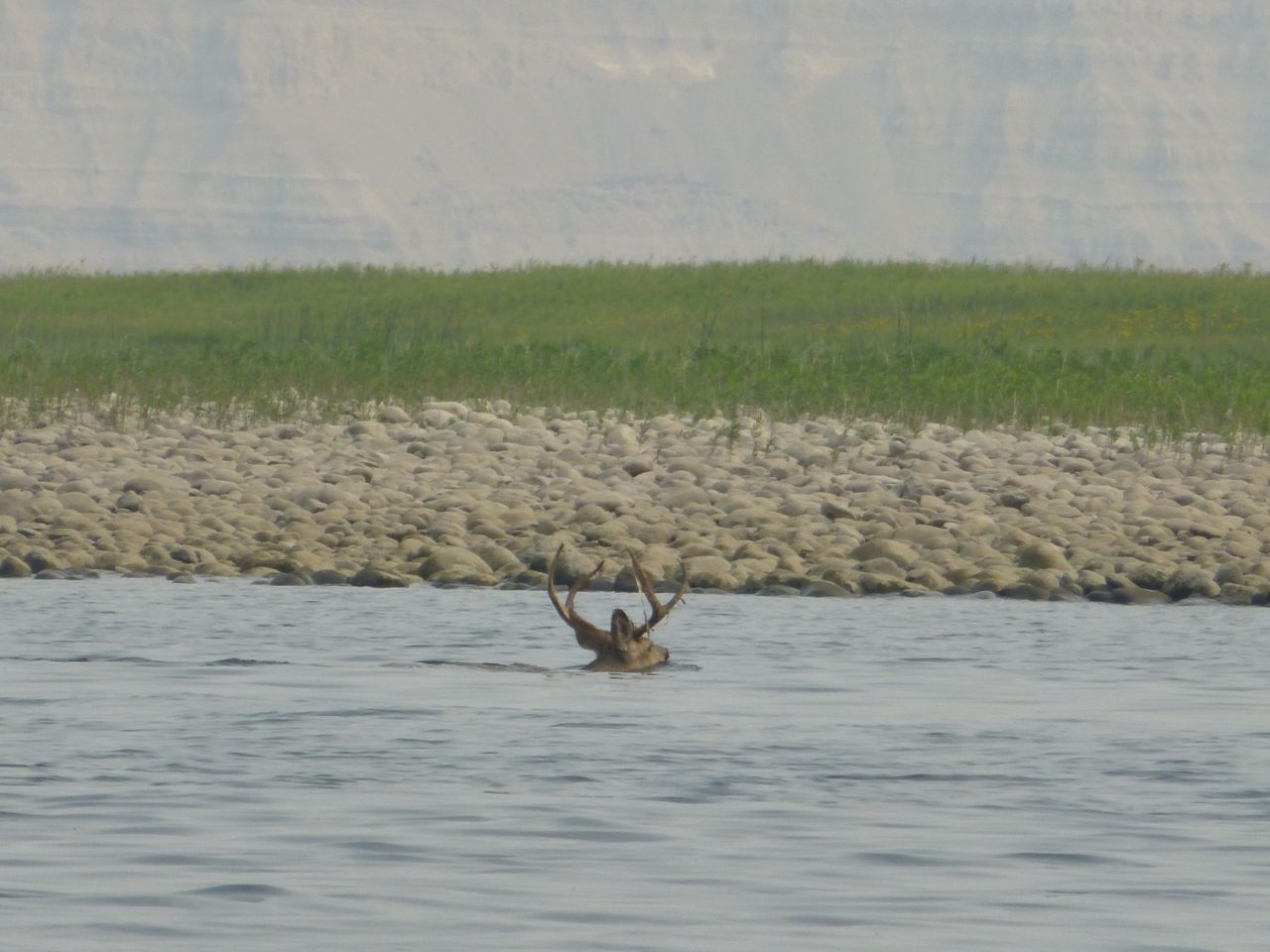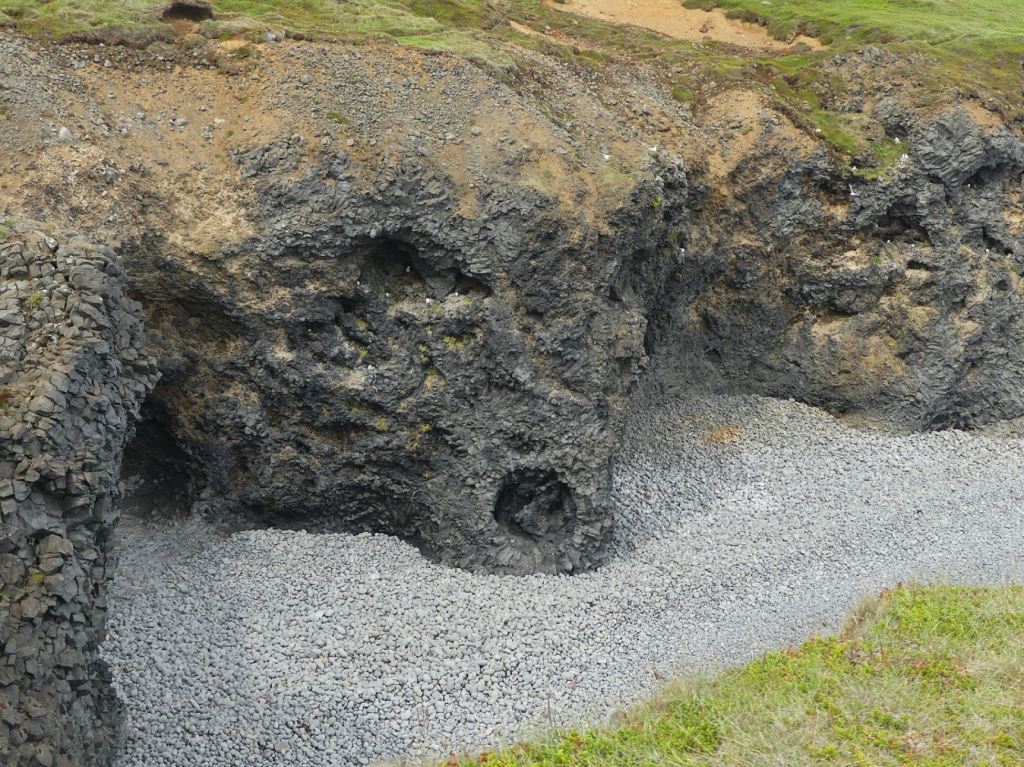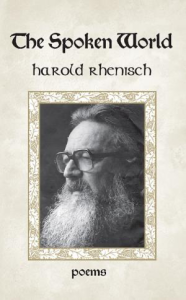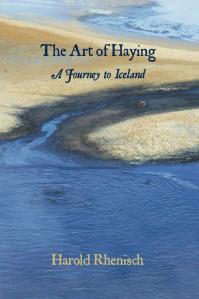People write poetry for many reasons. Any that is written is not poetry, though, but an incantation that allows for poetry, a force within the universe, to appear. People cannot be taught to bring these appearances forth in the world, because people are not in conscious control of a process that is, ultimately, not human. People can, however, be led to moments in which the possibility of appearance is possible. The rest is up to purity of heart. Not very modern thinking, is it. No. Here’s a moment of possibility:

That’s the Okanagan Nation fishery on the Okanagan River below a cliff that is an ancient story and which records the history of a war between the Syilx and Secwepemc people that ended with an agreement to share this land in the grasslands inland from the North East Pacific Shore. This is my home. Here is a cliff face in South Iceland. Geologists will point out, rightfully, that it is an ancient seashore cliff (that runs for a couple hundred kilometres) lifted away from the sea by tectonic forces. This image was taken from a point on the old seabed, for example. That kind of thing. It also has a stile and a beautiful woman who I love and who (I am blessed) loves me, walking through grass almost as tall as she is. This is a moment of my ancestral memory. It forms the foundation of my book The Art of Haying. It’s not, after all, a cliff. This is me.  It is also, if you have eyes to see, a troll, with two gaping eyes, a pug nose, and a broad, frog-like mouth, with water spilling off the top of its head and forming a farmyard spring. You can see the farmyard rhubarb patch to the right of the image, just above the green lump, which is the ruins of an old turf house. What I’m doing here is showing you how an image of the earth is seen when ancestral memory and contemporary thought are one. I am not asking you to agree with this, disprove this, argue it, or abstract it in any way because it is incontrovertible. Still, if you’re used to setting this kind of material deep within a form of romantic consciousness called the unconscious, subconscious, memory, fantasy, imagery, emotion, creative imagination, or any of the modern terms that separate your identity from it, a bit of a guide might prove interesting. You’re seeing a few things. The troll, for instance. A large-green headed ram below the troll’s right eye. An ewe’s skull, teeth bared, below his chin. Another below that. A scatter of human heads, all formed of stone, on the ledge above the bottom section of the falls, and a baby troll peering out of the steeply-angled green hill just to the left and behind the stile. What’s more, the troll has one eye open and one closed. It is Oðin, the Norse cultural hero who plucked out one eye at the well at the centre of the world as payment for receiving wisdom. There is much more, plus a beautiful woman walking through it. The image, framed by the boundaries of the technology of the camera, is called art, because it brings these correspondences into relief, but, hopefully, I have pointed out successfully that these images and correspondences are in the world, exactly in the way that modern humans, such as you or I, are trained to read or parse poetry. On that foundation, let me point out that when a man is one with his mind and with the earth, he looks out at the earth and sees himself. What that means is that walking through this landscape, I am walking through my thoughts, which is, of course, exactly the process of writing a poem. There are a few things, though, which the poetry of the world is not: fantasy, for instance, emotional confession, too, literary dialogue, for another. It’s not a portrait of my feelings, an exploration of my thoughts, or the opening of a social dialogue. It is not an installation or a performance. It is not art. And yet it is poetry. This is poetry:
It is also, if you have eyes to see, a troll, with two gaping eyes, a pug nose, and a broad, frog-like mouth, with water spilling off the top of its head and forming a farmyard spring. You can see the farmyard rhubarb patch to the right of the image, just above the green lump, which is the ruins of an old turf house. What I’m doing here is showing you how an image of the earth is seen when ancestral memory and contemporary thought are one. I am not asking you to agree with this, disprove this, argue it, or abstract it in any way because it is incontrovertible. Still, if you’re used to setting this kind of material deep within a form of romantic consciousness called the unconscious, subconscious, memory, fantasy, imagery, emotion, creative imagination, or any of the modern terms that separate your identity from it, a bit of a guide might prove interesting. You’re seeing a few things. The troll, for instance. A large-green headed ram below the troll’s right eye. An ewe’s skull, teeth bared, below his chin. Another below that. A scatter of human heads, all formed of stone, on the ledge above the bottom section of the falls, and a baby troll peering out of the steeply-angled green hill just to the left and behind the stile. What’s more, the troll has one eye open and one closed. It is Oðin, the Norse cultural hero who plucked out one eye at the well at the centre of the world as payment for receiving wisdom. There is much more, plus a beautiful woman walking through it. The image, framed by the boundaries of the technology of the camera, is called art, because it brings these correspondences into relief, but, hopefully, I have pointed out successfully that these images and correspondences are in the world, exactly in the way that modern humans, such as you or I, are trained to read or parse poetry. On that foundation, let me point out that when a man is one with his mind and with the earth, he looks out at the earth and sees himself. What that means is that walking through this landscape, I am walking through my thoughts, which is, of course, exactly the process of writing a poem. There are a few things, though, which the poetry of the world is not: fantasy, for instance, emotional confession, too, literary dialogue, for another. It’s not a portrait of my feelings, an exploration of my thoughts, or the opening of a social dialogue. It is not an installation or a performance. It is not art. And yet it is poetry. This is poetry:
 Ancestral Watcher at sx̌ʷəx̌ʷnitkʷ.
Ancestral Watcher at sx̌ʷəx̌ʷnitkʷ.
This is poetry:

nm∋lqaytkw at Chopaka
This is my home mountain and my home river.
Look at it this way: on a foundation of geology, weather and biological evolution, on a field of societal evolution and history, on a journey of personal presence and breath, in a unified consciousness, this is an image of my self, which reveals itself to me as I walk through it. Some nut has built a concrete water diversion structure in it, which is the way of modern, non-unified consciousness, but make no mistake: it is inside me. I have to accommodate that. That’s where I live, in a space in which every breath, every thought, everything I see and walk through, is poetry, which is not, I feel I should stress, not something I make, something that can be studied in a university department of literature, taught in a department of creative writing, or something anyone else can make. This is not something I made. It is vital to remove the traditions of book thinking from images like this. Book thinking? Yes. If you see a landscape in the following image and if you see a narrative in it:…
 Hanford Reach
Hanford Reach
… it is book intelligence you are viewing it with. Behind that green flood bar, just to the right of this image, the plutonium for the Trinity Test and the Nagasaki bomb was manufactured, as well as most of the plutonium for the Cold War. Does that stag look like he is swimming home? He isn’t. He is home. So am I. This is my poetry. Anyone can find Facebook on their own, god help them. To find their ancestral, non-human intelligence, the thing that makes them human, a guide helps. Here’s mine:
 Robin Skelton
Robin Skelton
He was the earth, standing up and walking. He was the sea. And I? I am here to tend an ancient fire
 I used to think that this fire could be kept burning in books, but that was before I realized that literature was a game of artifice and I was not speaking of artifice. I still passionately work with poetry, edit books of poetry, review them, write poetry, and walk through it daily, but I do so from the ancient context I hinted at above, because the work is to keep the world alive, all of it, or die. In my recent book of ghazals, Two Minds, the Sufic force of unified nature, the Sufic Green Man, Khdr, fills the body and mind emptied of self, the lost traveller or lover all-in-a-tangle, with the world, so that the world is there at the core of the soul’s movement through the world, not the technologically-created, abstract, book-based, Enlightenment self, as beautiful a piece of engineering as it is. We can be more.
I used to think that this fire could be kept burning in books, but that was before I realized that literature was a game of artifice and I was not speaking of artifice. I still passionately work with poetry, edit books of poetry, review them, write poetry, and walk through it daily, but I do so from the ancient context I hinted at above, because the work is to keep the world alive, all of it, or die. In my recent book of ghazals, Two Minds, the Sufic force of unified nature, the Sufic Green Man, Khdr, fills the body and mind emptied of self, the lost traveller or lover all-in-a-tangle, with the world, so that the world is there at the core of the soul’s movement through the world, not the technologically-created, abstract, book-based, Enlightenment self, as beautiful a piece of engineering as it is. We can be more.
 We are more.
We are more.
 Ancestors at Extreme Low Tide, Discovery Passage, Facing Cape Mudge …
Ancestors at Extreme Low Tide, Discovery Passage, Facing Cape Mudge …
… where their descendants live.
This is what I have learned during 58 years on this earth. It is not what I was taught. It is more. This is my standard for poetry. It must be alive. After all, I am a man of the earth. I am memory. I am the fire keeper.

























